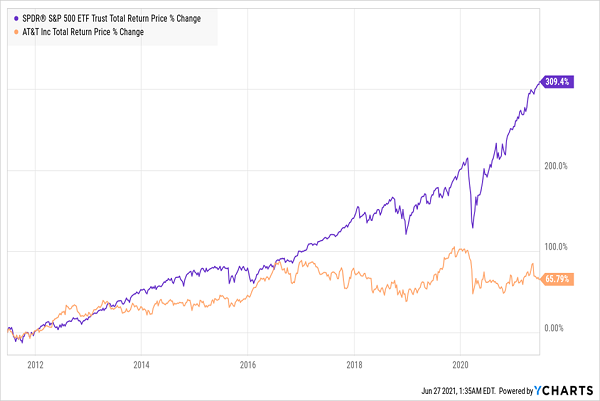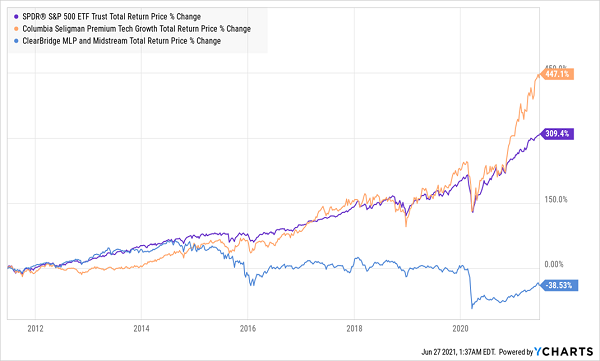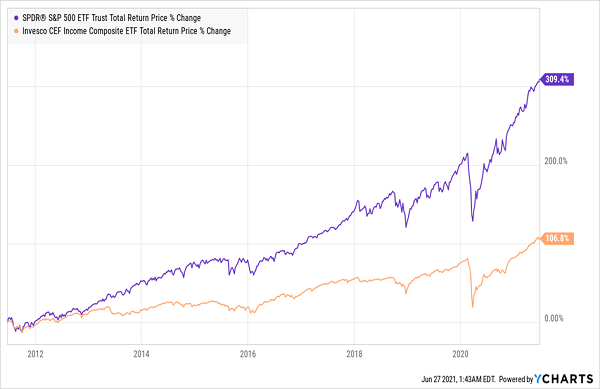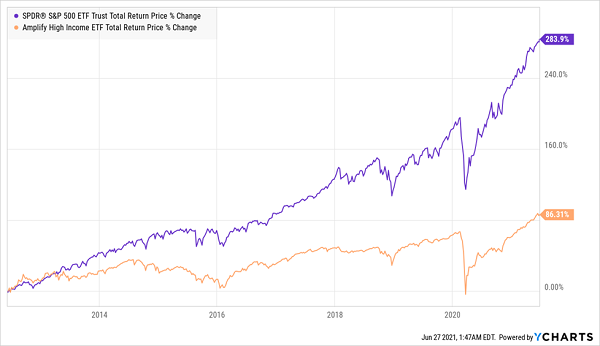Once folks get a taste of closed-end funds (CEFs), they typically rave about one thing: the dividends! Yields of 7% and up are common with CEFs, and they often come your way monthly.
We also love the fact that even though CEFs are a small corner of the market (with only about 500 or so out there), we can build a diversified portfolio with them: there are CEFs that hold US and international stocks, bonds, real estate—even private equity. You name it.
This broad range gets us around a problem most income-seekers face: being forced to stake significant sums in single stocks just to get big payouts. Often, this results in portfolios skewed toward certain sectors and delivering disappointing performance. It’s a story investors who’ve bought dividend go-to AT&T (T), whose yield routinely drifts above 6%, in the past know well. (In May, AT&T said it will cut its payout after it spins off its WarnerMedia business and merges it with Discovery Communications [DISCA].)
The Danger of Staking It on a Single High Yielder

But while we CEF buyers diversify, we must still choose our funds wisely, selecting those trading at unusually large discounts to net asset value (NAV, or the value of the investments in their portfolios) with the right mandates at the right times, as well as managers with proven histories.
Find a fund with all those strengths and you’ll give yourself a great shot at scoring a winner like the Columbia Seligman Premium Tech Growth Fund (STK), a 5.2% yielder that’s crushed the market over the last decade, with a 447% total return.
But the story would have been much different if you’d bought, and stuck with, the oil and gas–focused (and 6.6%-yielding) ClearBridge MLP and Midstream Fund (CEM), which underperformed drastically as that sector got hammered.
Best Versus Worst: A Big Range

There’s nothing new under the sun here: income-starved investors often ignore other flaws to get a big payout (in CEM’s case, a mandate that traps it in a volatile sector).
That’s why a fund’s yield is just one measure we evaluate at my CEF Insider service. Because we know that over time, CEFs with other strengths—like strong managers, proven histories and big discounts—will attract more investors, who will bid their prices skyward.
“All-in-One” Play Just Doesn’t Work With CEFs
Seeking out strong CEFs, of course, involves legwork. Some folks think they can get around that by purchasing a basket of CEFs through an algorithm-run exchange-traded fund (ETF). After all, the whole point of ETFs is to let us buy a bunch of stocks at once so we don’t have to choose winners and avoid losers ourselves. So can’t you just buy an ETF that holds CEFs and call it a day?
Such a move sounds great, but it just doesn’t work with CEFs. The history of the Invesco CEF Income Composite ETF (PCEF), a collection of CEFs that pays a 6.7% dividend yield, demonstrates this.
Good Intentions, Bad Idea

The reason for this is that PCEF combines a lot of underperforming CEFs, which means the fund itself drastically underperforms the market.
While we’re willing to accept some underperformance for a higher yield (PCEF’s 6.7% payouts are nice), having a profit two-thirds smaller than that of the index while taking on a similar amount of volatility is unacceptable. Plus you’ve got the problem of high fees: PCEF’s fee of 1.84% of assets, when combined with the fees on the CEFs in the fund, result in total expenses of 2.34%. (Those doubled-up fees are a particular problem for funds that devote their entire portfolios to owning other funds.)
Invesco is a great ETF company, but once you go beyond PCEF’s yield, you can see that it has little to offer.
Let’s Try That Again
Could the problem be PCEF? Maybe the ETF-of-CEFs approach works if you try a different fund.
Nope.
Fact is, all ETFs of CEFs have underperformed the market, and big income doesn’t compensate for this. Take the Amplify High Income ETF (YYY), which holds 30 CEFs and pays a 9% dividend. It’s done even worse than PCEF.
Second ETF of CEFs Falls Flat

What’s going on here is that YYY, like most ETFs, is locked in by the specs they use to select CEFs and can’t change course with shifts in the economy (unlike a CEF run by a human manager).
YYY chooses its CEFs by focusing on the fund’s yield (so making the same mistake AT&T and CEM investors made), discount to NAV (a strong indicator, to be sure, but not good enough on its own because some funds’ discounts never narrow) and liquidity. And for that, YYY investors must pay fees of 2.45% of assets—more than most CEFs with actual managers!
In short, until there is an ETF whose algorithm can replace a human manager—and that’s not in the cards anytime soon—carefully choosing a portfolio of CEFs is a much better solution than trying to take the ETF shortcut.
Crush ETFs (in Dividends and Price Gains) With These 7.3%-Yielding CEFs
I don’t know why you’d mess around with gimmicky ETFs like YYY when you could buy the 5 CEFs I’ll share with you right here. These 5 screaming bargains throw off rich payouts of 7.3%, on average, with the highest payer of the bunch yielding an incredible 8.3%!
In essence, buying these 5 CEFs lets you create your own ETF, but with far higher yields than any ETF of CEFs could ever give you (and lower fees, too)!
This is just the start, because I’m also offering, right now, a chance for you to road test my CEF Insider service for 60 days with no obligation whatsoever. When you do, you’ll get instant access to the 5 high-yielding CEFs I just mentioned, plus a trial membership to CEF Insider and its full portfolio of 14 CEFs (average yield: 6.7%).
You’ll also get my up-to-the-minute buy/sell/hold calls on ALL the CEFs I share with you in this comprehensive wealth-building package. And I’ll keep you constantly updated on any changes in my recommendations, too.
It really is the best of both worlds: the performance we want from an actively run portfolio with all the convenience of an ETF!
The whole package is waiting for you. Click here to get your free report with my top 5 CEFs (with 7.3% average yields and 20%+ price upside ahead) and your 60-day trial to CEF Insider, which unlocks my full portfolio of 6.7%+ yielding CEFs.
